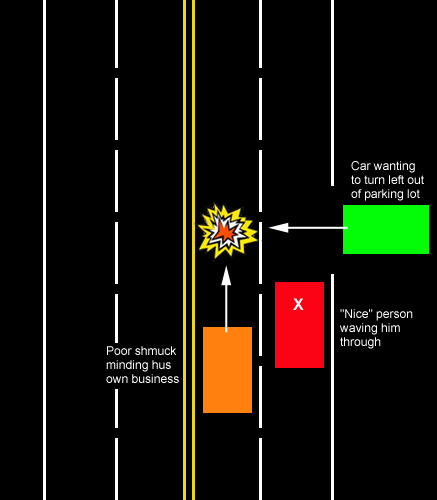Not surprisingly, a lot of flow tips I hear are related to driving. It makes perfect sense – driving is an activity almost always done in concert with others, and the stakes are high.
Let’s consolidate a few of these tips into a single post. Remember, flow is about everybody getting what they want. In the context of driving this usually means each driver arriving where hu is going, efficiently and intact:
Speed – Observe the speed of traffic and determine what speed you are going to hold in relationship to it. If highway traffic is going 80 and you’re only comfortable doing 65, stay to the right or center lanes to the extent that these lanes allow you to hold your chosen speed. Choosing a speed and holding it encourages concentration, and makes your vehicle more predictable to others. Conversely, if traffic is going 60, trying to go 80 is a danger to yourself and others. Nothing gives you the right to put the unconsenting in harm’s way.
Passing – Regardless of your chosen speed, the passing lane is for passing cars, not time. Pass quickly and decisively, then get the hell out of the left lane. People who camp in the left lane because it’s more convenient (on account of not having to deal with merging traffic) are selfish assholes. For those who say, “If I’m in the left lane doing 75 in a 65, that’s plenty fast for anyone,” feel free to fuck right off. You’re not a cop and we’re not your responsibility. If you still feel compelled to inflict this duty, bear in mind that you’re breaking the law doing it, which is fine if you’re willing to deal with the consequences, but odd if you are misguidedly encouraging others to obey it.
Merging – If you’re in the lane that merging traffic is trying to merge into, try to get out of it. If you can’t get out of the lane, hold your speed. The person merging into traffic is responsible for adjusting hus speed to find an opening. If you’re the one merging, for the love of God, don’t stop in the acceleration lane unless it’s absolutely necessary. You’ll have a hugely easier time merging into traffic if you’re going approximately the same speed as everyone else, and you won’t crap up those behind you.
Right of Way – Promoting flow does not necessarily mean being nice. Right of way promotes flow in that it gives everyone a common set of rules to know who gets to go first. I witnessed an ugly accident a couple of years ago caused by someone being nice (breaking with the right of way to do so). Yes, the person who took the invitation was ultimately responsible, but the “nice” person who waved him through created the situation and drove away moments later unscathed.

Obviously, letting someone in when traffic is crawling out of a stadium at one mile per hour is different. Otherwise, please learn the right of way rules (especially for less frequent stuff like four-way stops) and stick to them. Apparently they do this quaint little thing in Boston where oncoming traffic yields to the first person in line to turn left at a common green. That just makes me not want to go to Boston.
Awareness – Get in the habit of taking frequent “snapshots” of the traffic behind and beside you, even when you are not contemplating changing anything. Ideally, in an emergency situation you should be able to change lanes and/or brake hard without first having to look around.
Intersections – This one is pure flow. On roads with which you are familiar, identify intersections that do not have dedicated right-turn lanes, but get a lot of traffic wanting to turn right. If you’re going straight, stay out of the right lane so as to keep it free for those turning right on red. It costs you virtually nothing, while potentially allowing several people to get where they’re going that much quicker.
